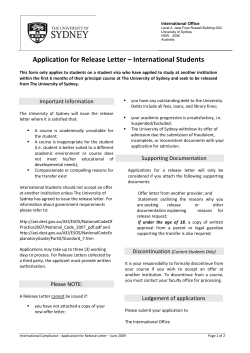
Functions: The domain and range Jackie Nicholas Jacquie Hargreaves Janet Hunter
Mathematics Learning Centre
Functions: The domain and range
Jackie Nicholas
Jacquie Hargreaves
Janet Hunter
c
2006
University of Sydney
1
Mathematics Learning Centre, University of Sydney
1
Functions
In these notes we will cover various aspects of functions. We will look at the definition
of a function, the domain and range of a function, and what we mean by specifying the
domain of a function.
1.1
What is a function?
1.1.1
Definition of a function
A function f from a set of elements X to a set of elements Y is a rule that
assigns to each element x in X exactly one element y in Y .
One way to demonstrate the meaning of this definition is by using arrow diagrams.
X
1
Y
f
X
5
2
1
Y
g
5
2
6
3
3
3
3
4
2
4
2
f : X → Y is a function. Every element
in X has associated with it exactly one
element of Y .
g : X → Y is not a function. The element 1 in set X is assigned two elements,
5 and 6 in set Y .
A function can also be described as a set of ordered pairs (x, y) such that for any x-value in
the set, there is only one y-value. This means that there cannot be any repeated x-values
with different y-values.
The examples above can be described by the following sets of ordered pairs.
F = {(1,5),(3,3),(2,3),(4,2)} is a function.
G = {(1,5),(4,2),(2,3),(3,3),(1,6)} is not
a function.
The definition we have given is a general one. While in the examples we have used numbers
as elements of X and Y , there is no reason why this must be so. However, in these notes
we will only consider functions where X and Y are subsets of the real numbers.
In this setting, we often describe a function using the rule, y = f (x), and create a graph
of that function by plotting the ordered pairs (x, f (x)) on the Cartesian Plane. This
graphical representation allows us to use a test to decide whether or not we have the
graph of a function: The Vertical Line Test.
2
Mathematics Learning Centre, University of Sydney
1.1.2
The Vertical Line Test
The Vertical Line Test states that if it is not possible to draw a vertical line through a
graph so that it cuts the graph in more than one point, then the graph is a function.
y
y
x
0
x
0
This is the graph of a function. All possible vertical lines will cut this graph only
once.
1.1.3
This is not the graph of a function. The
vertical line we have drawn cuts the
graph twice.
Domain of a function
For a function f : X → Y the domain of f is the set X.
This also corresponds to the set of x-values when we describe a function as a set of ordered
pairs (x, y).
If only the rule y = f (x) is given, then the domain
√ is taken to be the set of all real x for
which the function is defined. For example, y = x has domain; all real x ≥ 0. This is
sometimes referred to as the natural domain of the function.
1.1.4
Range of a function
For a function f : X → Y the range of f is the set of y-values such that y = f (x) for
some x in X.
This corresponds to the set of√y-values when we describe a function as a set of ordered
pairs (x, y). The function y = x has range; all real y ≥ 0.
Example
a. State the domain and range of y =
√
x + 4.
b. Sketch, showing significant features, the graph of y =
√
x + 4.
3
Mathematics Learning Centre, University of Sydney
Solution
√
a. The domain of y = x + 4 is all real x ≥ −4. We know that square root functions are
only defined for positive numbers so we require that x + 4 ≥ 0, ie x ≥ −4.√We also
know that the square root functions are always positive so the range of y = x + 4 is
all real y ≥ 0.
b.
y
3
1
x
–4
–3
–2
–1
The graph of y =
√
0
1
x + 4.
Example
a. A parabola, which has vertex (3, −3), is sketched below.
y
1
x
–2
0
2
4
6
–1
–2
–3
b. Find the domain and range of this function.
Solution
The domain of this parabola is all real x. The range is all real y ≥ −3.
Example
Sketch the graph of f (x) = 3x − x2 and find
a. the domain and range
b. f (q)
c. f (x2 ).
8
4
Mathematics Learning Centre, University of Sydney
Solution
y
2
1
x
–1
0
1
2
3
The graph of f (x) = 3x − x2 .
a. The domain is all real x. The range is all real y where y ≤ 2.25.
b. f (q) = 3q − q 2
2
c. f (x2 ) = 3(x2 ) − (x2 ) = 3x2 − x4
Example
The graph of the function f (x) = (x − 1)2 + 1 is sketched below.
6
y
4
2
x
–2
0
2
4
The graph of f (x) = (x − 1)2 + 1.
5
Mathematics Learning Centre, University of Sydney
State its domain and range.
Solution
The function is defined for all real x. The vertex of the function is at (1, 1) and therfore
the range of the function is all real y ≥ 1.
1.2
Specifying or restricting the domain of a function
We sometimes give the rule y = f (x) along with the domain of definition. This domain
may not necessarily be the natural domain. For example, if we have the function
y = x2
for
0≤x≤2
then the domain is given as 0 ≤ x ≤ 2. The natural domain has been restricted to the
subinterval 0 ≤ x ≤ 2.
Consequently, the range of this function is all real y where 0 ≤ y ≤ 4. We can best
illustrate this by sketching the graph.
4
y
2
x
–1
0
1
2
The graph of y = x2 for 0 ≤ x ≤ 2.
1.3
Exercises
1. a. State the domain and range of f (x) =
√
b. Sketch the graph of y = 9 − x2 .
√
9 − x2 .
2. Sketch the following functions stating the domain and range of each:
√
a. y = x − 1
b. y = |2x|
6
Mathematics Learning Centre, University of Sydney
c. y =
1
x−4
d. y = |2x| − 1.
3. Explain the meanings of function, domain and range. Discuss whether or not y 2 = x3
is a function.
4. Sketch the following relations, showing all intercepts and features. State which ones
are functions giving their domain and range.
√
a. y = − 4 − x2
b. |x| − |y| = 0
c. y = x3
d. y =
x
,x
|x|
= 0
e. |y| = x.
5. Write down the values of x which are not in the domain of the following functions:
√
a. f (x) = x2 − 4x
b. g(x) =
1.4
x
x2 −1
Solutions to exercises 1.3
√
1. a. The domain of f (x) = 9 − x2 is all real x where −3 ≤ x ≤ 3. The range is all
real y such that 0 ≤ y ≤ 3.
b.
4
y
2
x
–4
–2
0
The graph of f (x) =
2
√
9 − x2 .
4
7
Mathematics Learning Centre, University of Sydney
2. a.
b.
y
y
4
4
2
2
x
x
0
1
3
5
–2
√
The graph of y = x − 1. The domain
is all real x ≥ 1 and the range is all real
y ≥ 0.
0
2
The graph of y = |2x|. Its domain is all
real x and range all real y ≥ 0.
c.
y
2
0
2
The graph of y =
1
.
x−4
4
8 x
6
The domain is all real x = 4 and the range is all real y = 0.
d.
y
4
2
x
–2
0
2
–1
The graph of y = |2x| − 1. The domain is all real x, and the range is all real
y ≥ −1.
3. y 2 = x3 is not a function. If x = 1, then y 2 = 1 and y = 1 or y = −1.
8
Mathematics Learning Centre, University of Sydney
4. a.
b.
y
y
2
2
x
–2
x
2
0
–2
–2
–2
√
The graph of y = − 4 − x2 . This is a
function with the domain: all real x such
that −2 ≤ x ≤ 2 and range: all real y
such that −2 ≤ y ≤ 0.
c.
2
0
The graph of |x| − |y| = 0. This is not
the graph of a function.
d.
y
y
2
2
x
–2
0
x
2
–2
–2
0
2
–2
The graph of y = x3 . This is a function
with the domain: all real x and range:
all real y.
e.
x
The graph of y = |x|
. This is the graph
of a function which is not defined at x =
0. Its domain is all real x = 0, and range
is y = ±1.
y
2
x
0
2
–2
The graph of |y| = x. This is not the graph of a function.
5. a. The values of x in the interval 0 < x < 4 are not in the domain of the function.
b. x = 1 and x = −1 are not in the domain of the function.
© Copyright 2025





















